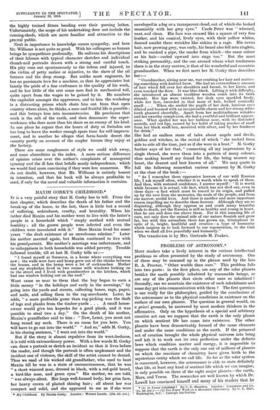PROBLEMS OF ASTRONOMY.*
MOST readers take a lively interest in the curious intellectual problems so often presented by the study of astronomy. One of these may be summed up in the phrase used by the late R. A. Proctor, " Other worlds than ours." This problem falls into two parts : in the first place, are any of the solar planets besides the earth possibly inhabited by reasonable beings, or are any of the planets that circle other suns so inhabited ? Secondly, can we ascertain the existence of such inhabitants and some day get into communication with them ? The first question is one really for the philosopher, guided by the conclusions of the astronomer as to the physical conditions in existence on the surface of our own planets. The question in general would, on a priori grounds, be answered by most modern thinkers in the affirmative. Only on the hypothesis of a special and arbitrary creative act can we suppose that the earth is the only planet on which sentient life has come into existence. The other planets have been demonstrably formed of the same elements and under the same conditions as the earth. If the primeval act of creation brought the whole physical universe into being and left it to work out its own perfection under the definite laws which condition matter and energy, it is impossible to suppose that the earth is the only one out of millions of planets on which the reactions of chemistry have given birth to the mysterious entity which we call life. So far as the solar system is concerned, however, the astronomer is able to state definitely that life, at least any kind of sentient life which we can imagine, is only possible on three of the eight major planets—the earth, Mars, and Venus. The researches are well known by which Dr. Lowell has convinced himself and many of his readers that he • (1) Is Venus Inhabited I By C. E. Housden. London : Longinus and Co. [Ix. 6d. net.]—(2) Ten Years' Work on a Mountain Observatory. By U. E. Halo. Washington, D.C. : Carnegie Institution.
Las discovered evidence of a high form of intelligence being at work in Mars. A vast system of irrigation is believed to be in operation in that_ arid planet, the so-called " canals '; which are visible through powerful telescopes being in .reality belts of vegetation which pass through the same seasonal changes as take place on the earth. Mr. Housden c now applies somewhat similar reasoning to Venus, using the observations of Dr. Lowell for that purpose. Unlike the earth and Mars, Venus always turns the same face to the sun. Thus one of her hemispheres will enjoy perpetual day, the other perpetual night. The former would be intolerably torrid for habitation, the latter must be bound in perpetual chains of ice. Mr. Housdeu pos- tulates, reasonably enough, the existence of an intermediate zone, perhaps a thousand miles wide and twenty-four thousand in length—since it stretches right round the planet. The tem- peratures on this strip would cover the terrestrial range—say from to lte F.—and life in our sense would be possible upon it. Mr. Housden tries to show that such life does exist, and that the inhabitants have established another irrigational system. akin to that of Mars, traces of which are visible in the telescopic appearance of Venus. So far there is nothing excessive in his demands on the reader's credulity. But when he goes on to calculate that the system must involve the use of two hundred thousand pipes, each.six feet in diameter and two thousand five hundred miles long, and that seventeen thousand million horse- power would be required to keep it working. we feel that he has somewhat overdone himself, and that we should like better evidence of the inhabitants of Vemis before we can rate their engineering capabilities on this grand scale.
Dr. G. E. Hale, who is one of the most eminent of living astronomers, has written a lucid and interesting pamphlet 2 for the -Carnegie Institution in which he summarizes the work done in the past ten years at the Mount Wilson Observatory in California, where the greatest telescope ever made-=the hundred-inch reflector—is now being prepared to search the heavens. It is needless to say that Dr. Hale's account is both authoritative in matter and pleasant in style.



















































 Previous page
Previous page